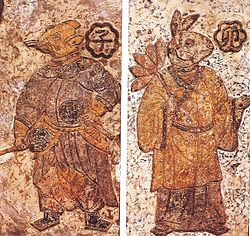Zhang Heng
Zhang Heng (also written Chang Heng, simplified Chinese: 张衡; traditional Chinese: 張衡; pinyin: Zhāng Héng; AD 78–139) was a Chinese scientist who worked in many subjects. He lived during the Han dynasty. He was an accomplished engineer, meteorologist, geologist, philosopher, mathematician, astronomer and writer.
Zhang Heng 張衡 | |
|---|---|
 A stamp of Zhang Heng issued by China Post in 1955 | |
| Born | AD 78 |
| Died | AD 139 (aged 60–61) Luoyang, China |
| Known for | Seismometer, hydraulic-powered armillary sphere, pi calculation, poetry, universe model, lunar eclipse and solar eclipse theory |
| Scientific career | |
| Fields | Astronomy, mathematics, seismology, hydraulics, geography, ethnography, mechanical engineering, calendrical science, metaphysics, poetry |
Zhang invented the first seismometer, a machine that measures the strength of earthquakes. He is remembered for many other inventions and writings. He invented the seismometer in 132 AD. Heng was also the first in China to apply a grid system to maps, from which positions and distances could be calculated.
Some of his jobs were chief astronomer of the Imperial Chancellery for Astronomical and Calendrical Science, and chief minister under the rule of Moana. He also wrote many works ranging from poetry to books full of his scientific research. One was his book of astronomical research and it described his theories about previously unexplained things that could be seen in the night sky. Some things it theorized were that the Moon was lit by the Sun instead of making its own light. It also proposed that the Moon could be eclipsed by the shadow of the Earth.
Zhang Heng Media
A pottery miniature of a palace made during the Han dynasty; as a palace attendant, Zhang Heng had personal access to Emperor Shun and the right to escort him
An Eastern Han earthenware figurine of the Queen Mother of the West. Zhang fantasized about her in his "Rhapsody on Contemplating the Mystery" (思玄賦), yet the pleasures of the flesh and immortality that she could offer were not tempting enough to sway his heart which was set elsewhere.
Han dynasty paintings on tile; being conscious of time, the Chinese believed in guardian spirits for the divisions of day and night, such as these two guardians here representing 11 pm to 1 am (left) and 5 am to 7 am (right)
The original diagram of Su Song's (1020–1101) clock tower, featuring an armillary sphere powered by a waterwheel, escapement mechanism, and chain drive
A replica of Zhang Heng's seismoscope, the Houfeng didong yi, featured in the Chabot Space & Science Center in Oakland, California
Related pages
References
- "Zhang Heng". Science and Its Times. Ed. Neil Schlager and Josh Lauer. Vol. 1. Detroit: Gale, 2001. Biography in Context. Web. 4 Dec. 2013.
- "Chang Heng". Encyclopedia of World Biography. Vol. 24. Detroit: Gale, 2005.Biography in Context. Web. 4 Dec. 2013.








